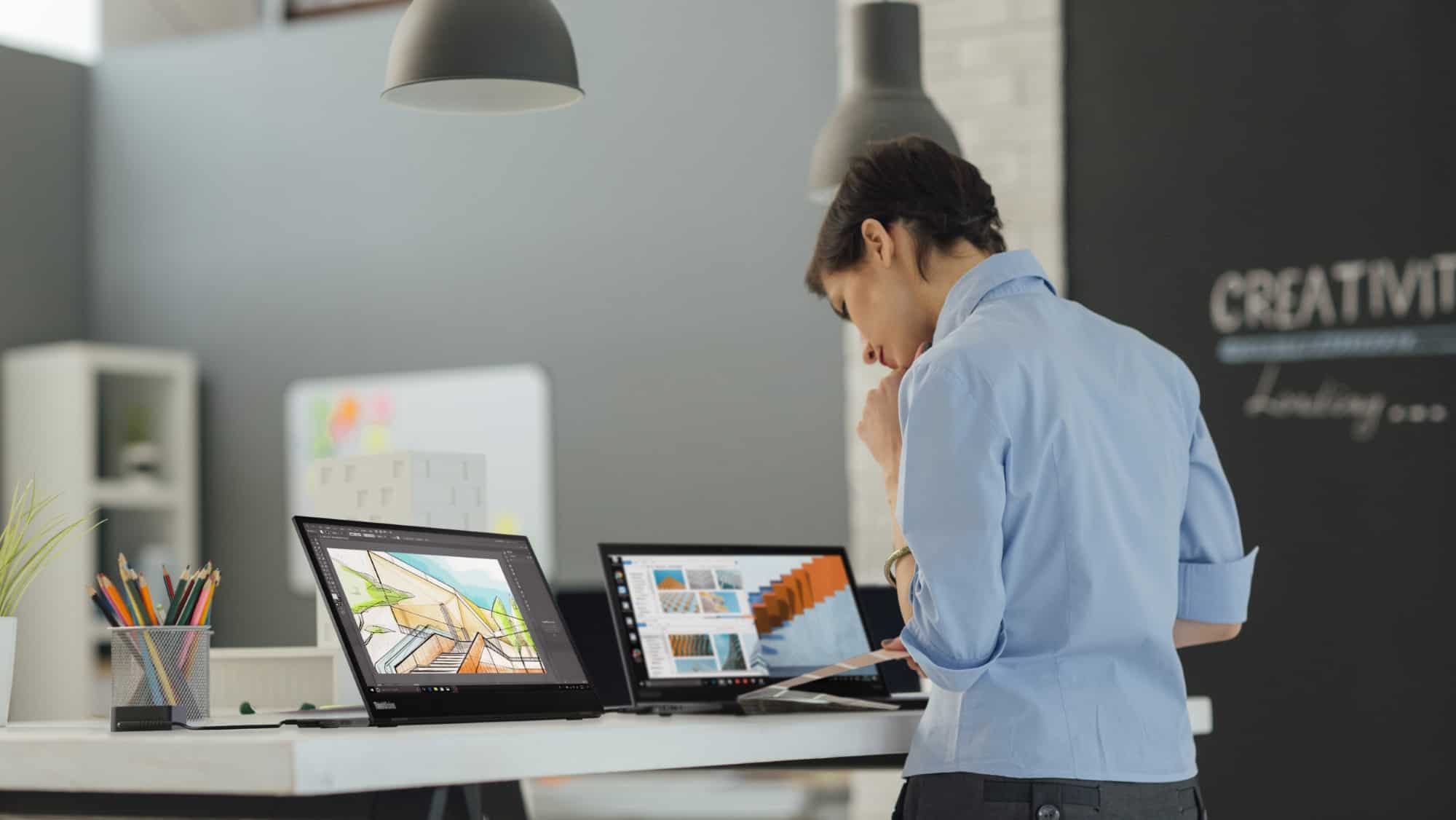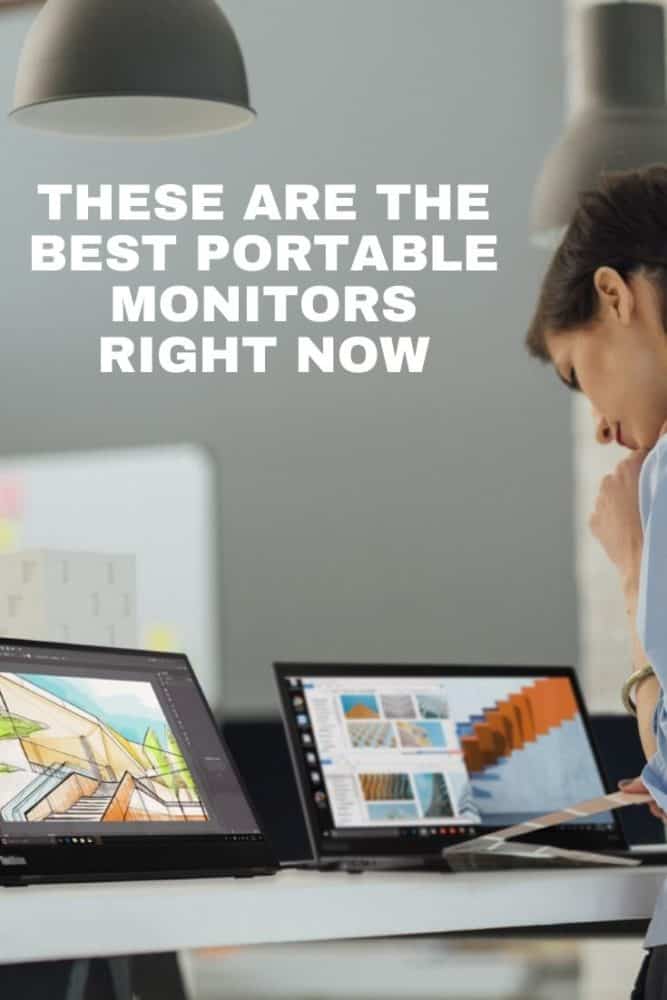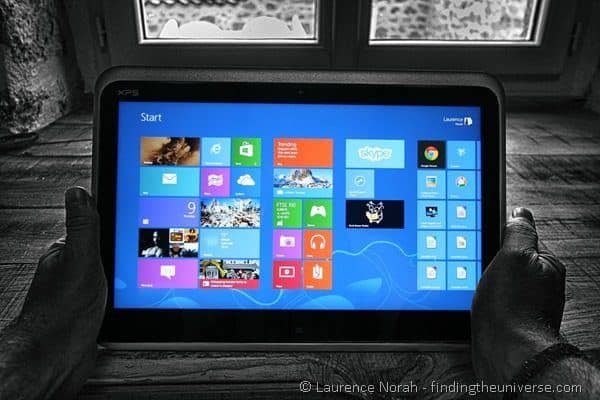The Best Portable Monitors of 2023
We may earn a commission from purchases you make after clicking links on this site. Learn more.While monitors have been technically “portable” for decades, lightweight models that fit into a carry case rather than a station wagon are a more recent invention. Versions that you’d actually want to use? They’re even newer still.
While the benefits of a second screen are undeniable, we didn’t recommend any portable monitors on this site for a long time. They were just too expensive, had dim displays, didn’t work very well, and were still too big and heavy to really want to take outside the house with you.
That’s all changed in the last few years, as screen technology got better and lighter, USB C got rid of the bulky cables and chargers, and competition drove the price down. Several companies are now making portable monitors worth owning, with sizes and features to suit a wide range of needs.
We’d still suggest using a normal monitor if you work from the same space all the time, since you get much more for your money. If you’re a laptop user who travels regularly, often finds yourself hitting deadlines from the cafe, or needs to set up and take down your home office every day, however, a portable version makes a lot more sense.
Whether you’re on a budget, looking for the lightest version, or need a larger display or a touchscreen, these are the best portable monitors of 2023.
- Dimensions (incl. stand): 12.7 x 8.2 x 3.8 inches (32.3 x 22 x 9.7cm)
- Weight: 1.3 pounds (598g)
- Display Size: 14 inches
- Resolution: 1920x1080 @ 60Hz
- Nominal Brightness: 300 nits
- Connection Type: 2 x USB C
- Dimensions: 12.8 x 8.1 x 0.5 inches (32.6 x 20.4 x 1.2cm)
- Display Size: 14 inches
- Resolution: 1920 x 1080 @ 60Hz
- Nominal Brightness: 300 nits
- Connection Type: USB C, micro-HDMI
- Dimensions: 15.7 x 9.9 x 0.4 inches (39.9 x 25.0 x 1.0cm)
- Weight: 2.3 pounds (1043g)
- Display Size: 17.3 inches
- Resolution: 1920x1080 @ 240Hz
- Nominal Brightness: 300 nits
- Connection Type: USB C, micro-HDMI
- Dimensions: 14.5 x 8.8 x 0.3 inches (36.9 x 22.4 x 0.9cm)
- Weight: 1.7 pounds (757g)
- Display Size: 15.6 inches
- Resolution: 1920x1080 @ 60Hz
- Nominal Brightness: 300 nits
- Connection Type: USB C, mini-HDMI, USB-A
- Dimensions: 14.2 x 8.9 x 0.4 inches (36 x 22.7 x 0.9cm)
- Weight: 2 pounds (900g)
- Display Size: 15.6 inches
- Resolution: 1920x1080 @ 60Hz
- Nominal Brightness: 250 nits
- Connection Type: USB C, USB-A adapter, micro-HDMI
- Dimensions: 14.6 x 9.3 x 0.5 inches (37.1 x 23.5 x 1.3cm)
- Display Size: 15.6 inches
- Resolution: 3840 x 2160 @ 60Hz
- Nominal Brightness: 400 nits
- Connection Type: USB C, mini-HDMI
- Dimensions: 14.1 x 8.9 x 0.4 inches (35.8 x 22.5 x 1.1cm)
- Weight: 1.8 pounds (830g)
- Display Size: 15.6 inches
- Resolution: 1920x1080 @ 60Hz
- Nominal Brightness: 250 nits
- Connection Type: USB C, USB-A
What to Look For in a Portable Monitor
To help you understand why we chose the models we did, but also to provide a starting point for you to do your own research, these are the key factors that influenced our portable monitor selections.
Size and Weight
The critical factor for selecting a portable monitor is, well, portability. You’re going to be carrying the monitor from place to place, after all, usually alongside your laptop and other gear. That’s a lot of stuff to lug around, which is why size needs to be one of the first things you consider.
Before opting for the smallest model on the market, however, remember that display size will have a big influence on how useful your monitor actually is. A larger screen is more comfortable to use, but every extra inch adds more bulk, so choose wisely.
As a general rule, anything below 14 inches is suboptimal: it’s basically tablet territory at that point. Somewhere around 15 inches is standard, neither too big nor too small for most uses, while 17+ inches compromises portability but is better suited for gaming and graphic design.
As for weight, it certainly plays a role when traveling, but the majority of the monitors fall into the same range of about 200-300 grams (7-11oz), give or take. Weight matters, but don’t make your decision solely based on that: the display size and other criteria and features are far more important.
Picture Quality
Picture quality is by far the most important aspect of any monitor, and portable ones are no exception. The problem is, unfortunately, that the increased portability can mean a worse display, which shows up particularly in lower-priced models.
Here is what to look for when comparing picture quality:
- Resolution: the more pixels a monitor has, the better the image quality. HD/1080p resolution (1920×1080 pixels) should be the minimum, but there are 4k-capable options as well.
- Colors: you want your monitor to have accurate color reproduction and to be able to display the whole color gamut. This matters especially for graphic artists and photographers.
- Brightness: because you’re likely to use your portable monitor in different lighting conditions and environments, it’s important to pick a bright one. Usually measured in nits, look for a minimum of 250, ideally around 300-400 or more. Being able to dial the brightness up and down is also useful for conserving battery and avoiding eye strain in dark rooms.
- Refresh rate and response rate: these two stats are essential for gamers in particular, relating to how smoothly the monitor displays fast-moving scenes. The refresh rate is measured in hertz (Hz), and higher is better; the response rate is described in milliseconds (ms) and should be as low as possible.
Intended Use
While the monitor you choose needs to be portable, it also needs to meet your specific needs. While most models do a reasonable job of standard work-related tasks, gamers, photographers and graphic artists, and others have specific needs that makes certain monitors a better choice than others.
That doesn’t mean you can’t use those monitors for any other purpose: it only means they have particular features that make them more suitable for a specific type of user. Those features usually add to the total price, though, so make sure you’ll use them before spending the extra cash.
Additional Features
With your intended use in mind, there are a few extra features that can come in handy in certain situations. If they apply to you, bear them in mind when picking a portable monitor.
- Anti-glare screen: choosing a monitor with a matte screen or anti-glare coating will make your life much easier if you plan to use your monitor outside or near a window. Considering that we’re talking about portable monitors here, this feature is more important than it first seems.
- Connections: HDMI is the standard connection type, and you can expect to find it in every modern monitor. The same goes for USB C ports these days, but if you’re using an older laptop, you should look into USB-A options as well.
- Touchscreen: touchscreen monitors are especially useful for creatives, and some come with a stylus that turns them into a (large) drawing tablet. Make sure that the touch component of whichever model you’re considering works with your operating system(s) of choice.
- Battery: a built-in battery provides greater autonomy, as the monitor won’t leach off your laptop for energy or require you to sit close to a wall outlet all the time.
- Speakers: having built-in speakers can come in handy in some situations (like presentations), but don’t expect miracles when it comes to either sound quality or volume.
- Stability: most portable monitors have some kind of stand that holds them in place on their own. Some also have tripod support, which provides even more stability (if you have a decent tripod, of course!). This is particularly important if you use the monitor outside or somewhere it can be easily knocked.
- Health-friendly features: a blue light filter is a welcome feature, since it can help you sleep better and save your eyes from too much straining in dark rooms. The same goes for flicker reduction. Some monitors also have an anti-bacterial coating, which became a much more desirable feature in the last few years!
Price
Price is almost always a factor, of course, and helps you cull out models that break your budget. That said, while we have cheaper models on our list, try not to make decisions on price alone, but rather be cost-conscious.
If opting for a budget pick is necessary, choose wisely. Manufacturers need to drop features to produce a portable monitor cheaply, so it’s your job to identify that compromise, and ensure you’re okay with the decision that’s been made for your particular situation.
For example, if you don’t plan to game much, it’s reasonable to sacrifice refresh and response rates. If you’re not a fan of touch screens, good for you: those models are usually more expensive. While having a higher resolution is better, it’s not always necessary: maybe 4k is overkill for your specific needs.
We’d also suggest that having an unlimited budget doesn’t mean you should automatically buy the most expensive model. Who cares about all those extra features if you’ll never use them? Try to make a wise choice even when splurging!
Best Portable Monitor for Work: Lenovo ThinkVision M14

If we were going to pick the two most important features in a work-focused portable monitor, they’d have to be weight and picture quality. Apparently Lenovo had the same idea, and came up with the ThinkVision M14 as a result.
The 14″ display is a little smaller than most of the competition, but it still has the same 1920×1080 FHD resolution that we typically see. This makes for a slightly sharper image than usual, and in this case, a lot less weight. At just 1.3 pounds, it’s significantly lighter than our other recommendations.
The M14 has an unusual design, with the screen connected to a fold-up base via a fancy hinge mechanism. The display itself is just 0.17″ (4.4m) thick, and can be adjusted to an angle anywhere from -5 to 90 degrees. The base unit holds all of the ports and circuitry.
There’s a small “foot” on the front of the base that can be flipped down for extra height, and the monitor stays solidly in place in both landscape and portrait orientation. Overall, there’s a lot more viewing flexibility than anything else on this list.
Color reproduction isn’t the strong suit of most portable monitors, but here again the M14 shines, with accurate colors across the range. It’s also nice and bright, and the anti-glare coating means you’ll still be able to see what’s on the screen even under harsh fluorescents or sunlight.
The monitor has two USB C ports, one on each side. It draws power from the laptop as usual, but also supports 65W power pass-through so you can plug your charger into one side, your laptop into the other, and power both at once. That’s useful if your laptop only has a single USB C port.
Note that USB C is your only connection option: there’s no support for USB-A DisplayLink, HDMI, or anything else. That shouldn’t be an issue with recent laptops, but will be with older ones.
The minimal weight, impressive color reproduction, and sturdy, flexible stand combine to make the ThinkVision M14 our top portable monitor pick for work-based tasks. As long as you have a recent laptop with USB C, there’s an awful lot to like and very little to complain about.
Pros
- Very lightweight
- Good color reproduction and brightness
- Base acts as a sturdy stand
- Flexible screen angle
- Two USB-C ports, with power pass-through
Cons
- USB-C only. No USB-A or HDMI support for older machines
Best Portable Monitor for Creatives: ASUS ProArt Display PA148CTV

The words “portable monitor” and “creative work” don’t typically go together, especially if that creative work has a visual component. Small screens with poor color accuracy are the norm, and anyone doing serious graphical work will be better served by any decent desktop display.
With that out of the way, there are a (very) few manufacturers that make the effort to build portable monitors with creatives in mind. Of the limited range on offer, the best we’ve found so far is the ASUS ProArt Display PA148CTV.
The 14″ display covers 100% of the RGB and Rec.790 color gamuts, and comes factory pre-calibrated (although you can tweak this yourself as needed). In a nod to graphic artists, there’s a jog wheel on the side that’s compatible with apps like Photoshop, as well as Microsoft’s Surface Dial for more general uses.
Given its target audience, it’s perhaps no surprise that color accuracy is significantly better than any of the other general-purpose monitors we mention above. Thanks to the higher pixel density that comes with its smaller size, text is also very crisp and clear, even at small font sizes.
Powered via USB C PD, you can connect via either USB C or micro-HDMI. A pair of 1W speakers are built in, although like many, they’re unlikely to be much better than what comes with your laptop. 10-point touch support is built in, but only on Windows: Mac owners are out of luck.
Rather than the usual folio cover and stand that most portable monitors use, the PA148CTV has a fold-out metal kickstand that’s noticeably more stable. You can also mount the monitor on a tripod, which (assuming the tripod is sturdy enough) lets you raise the screen to a more ergonomically-friendly height.
As you’d expect, this monitor makes for a very good general-purpose display as well. Like all of the others on this list, however, it’s not very exciting for gaming thanks to the fixed 60Hz refresh rate and relatively slow input delay.
It’s pretty bright for a portable monitor, and has a matte screen coating that keeps the worst of the reflections away, so it’s at least somewhat usable outdoors. Even so, it’s not as good as the best laptop displays in direct sunlight, and we wouldn’t choose to regularly use it this way.
If you’re a traveling graphic artist or other creative that needs highly-accurate colors, you’ll definitely benefit from the PA148CTV despite its small size. Others will certainly find it useful as well, but it’s a harder sell (at least at usual pricing) compared to our top pick. Keep an eye out for a discount!
Pros
- Much better color reproduction than most portable monitors
- Crisp text
- Touch-enabled
- Kickstand better than most, plus tripod mounting available
Cons
- Small for the intended use of creative work
- Touch support only available on Windows
Best Portable Gaming Monitor: Asus ROG Strix XG17AHPE

If you’re planning to game with a portable monitor, especially if you prefer fast-paced action titles, the usual models won’t really cut it. Size and refresh rate start to matter a lot more, since small, laggy screens leave you at a significant disadvantage.
We’ve checked out a number of supposedly gaming-focused portable screens, many of which disappoint in the real world. For us, the Asus ROG Strix range consistently provides the best mix of features at prices that, while noticeably more expensive than other models, aren’t unreasonable for what you get.
Right now, our pick is the XG17AHPE, a 17.3″ monitor that despite its larger screen size, weighs in at a reasonable 2.3 pounds or little over a kilogram. It’s surprisingly portable for what it is, and the stand doubles as a basic screen cover for extra protection while not in use.
The extra size is super-useful while gaming, and while we wouldn’t have minded a higher resolution than 1920×1080, it’s not the end of the world. FHD is fine for a gaming-focused 17-inch display: unless you’ve got a high-end graphics card, you’re unlikely to be playing at higher resolutions anyway.
The standout feature, however, is the 240Hz refresh rate. That’s higher than anything else on this list, and paired with the super-fast response time, makes a real difference in FPS, racing, and other fast-moving games. In short, you’ll notice far less blur with the XG17AHPE than almost any other portable monitor.
The good bits don’t end there, however: like some of the other portable monitors in the Asus range, the XG17AHPE comes with stereo speakers and an inbuilt battery. Its 7800mAh capacity lets you run the screen for around two hours at max refresh rate and brightness, and up to five hours at lower levels.
The peak brightness of 300 nits is about as good as you’ll find from a portable display, and color reproduction is also very good: on par with the Thinkvision M14, and much better than most cheaper models.
If you game on the go and want a portable screen to do it with, look no further: right now, the XG17AHPE is where it’s at.
Pros
- Excellent refresh rate
- Fast response rate
- Good brightness and color reproduction
- Inbuilt battery
Cons
- Fairly expensive
Best Budget Portable Monitor: Lepow Z1 Gamut

You’ve basically got two choices when it comes to portable monitor manufacturers: one of a handful of major brands (Lenovo, HP, Asus) or any number of Chinese companies you’ve never heard of. Lepow is very much the latter, but it’s actually been in the market for quite a while.
The Z1 Gamut is an upgraded version of the popular Z1 model, with basic specifications that are exactly what you’d expect from a budget portable monitor: 15.6″ display, 1920×1080 resolution, mediocre brightness and color reproduction.
What sets the Z1 Gamut apart from the dozens of other no-name portable monitor brands, then? It’s the little things. For starters, as well as the ubiquitous USB C, there’s also a micro-HDMI port on the monitor and the appropriate cables to use either option.
The case turns into a stand, as usual, but there are two grooves in the base to give at least some choice of viewing angle. The stand only works in landscape mode, but the monitor itself supports portrait mode: you’ll just need to find a different way of keeping it in position.
For a 15.6″ monitor, the Z1 Pro is surprisingly light at 1.7 pounds. Even with that low weight, there are a pair of speakers built into the monitor, along with a headphone jack. The speakers are quite weak, so you’re more likely to use the ones on your laptop, but still, it’s a nice touch.
The biggest problems with this monitor are the color reproduction and brightness. As with many others, reds and purples appear quite washed out, and while you can change various settings to try and make up for it, the alternative is having every other color look unnaturally saturated.
The “Gamut” in the name refers to this monitor’s ability to display a wider range of colors than its predecessors. That’s useful, as far as it goes, but since the accuracy of those colors isn’t particularly impressive, it’s not something to get especially excited about.
The brightness level also isn’t great. While the 300 nits listed in the specifications is even higher than our top picks, the Z1 Pro is much dimmer in the real world. It’ll be fine indoors in normal lighting, but don’t expect great visibility in direct sunlight.
If neither of those things is a deal-breaker, the Z1 Gamut offers plenty of monitor for not a lot of money in a lightweight and easily transportable package. Throw in a three-year warranty, and you have our budget portable monitor choice for 2023.
Pros
- Good price
- Inbuilt speakers
- HDMI support as well as USB C
- Lightweight for a 15.6″ model
Cons
- Poor color reproduction
- Not as bright as the specifications suggest
- Stand doesn’t support portrait mode
Best Portable Touch-Screen Monitor: Asus Zenscreen Touch MB16AMT

If you’re used to having a touchscreen on your laptop display, there’s no reason you can’t have one on your second monitor as well. As the name suggests, the Asus Zenscreen Touch is the touch-enabled version of the Go model mentioned above, with almost exactly the same specifications.
There’s the same 1920×1080 resolution on a 15.6″ display, the same internal battery so you don’t need to draw power from your laptop, and the same muted color palette that’s common to pretty much every portable monitor except the Thinkvision M14.
The main difference, of course, is the screen. Multitouch-enabled, you’ll get full touch support on Windows and some Android devices, limited support on macOS (since it’s not built into the operating system,) and none on iOS. It’s relatively bright for a portable monitor, which is a nice change.
As with the non-touch model, you get an Asus e-ink pencil in the box, but here you can use it for more than holding the screen upright. Whether you’re using your finger or the stylus, the display is reliable and quick to respond to your input.
Controlling the various settings is done via a single button on the bottom of the monitor that’s actually a five-way joystick. It’s one of the better approaches to menu navigation we’ve seen, but there’s also a Windows app that lets you configure many of the same settings.
The Touch works over either USB C or the combination of micro-HDMI and USB-A, and all of the cables and adapters you need come in the box. There’s a pair of speakers built-in, which work fine but are probably no better than the ones you have on your laptop already.
Weighing only slightly more than it’s non-touch siblings, if you’re looking for the best portable touchscreen monitor of 2023, you’ve found it in the Asus Zenscreen Touch.
Pros
- Touchscreen works well
- Comes with a stylus
- Both USB-C and HDMI/USB-A options
- Internal battery
Cons
- Heavier than non-touch models
- Colors somewhat dull
Best Portable 4K Monitor: UPERFECT True 4K Portable Monitor

The vast majority of portable monitors max out at FHD (1920×1080) resolution, and for many users, that’s perfectly fine. For those who want something better, however, options are quite limited, and good options are even more limited still.
That’s why you could do a lot worse than checking out the UPERFECT True 4K Portable Monitor. Reasonably priced and full of features, it’s a display that’s pitched at gamers but is equally useful for anyone else needing a high-resolution portable display at a reasonable price.
The 3840×2160 resolution is coupled with a 60Hz refresh rate, and 3-5ms response time, which is reasonable (although not amazing) for gaming. It has both USB C and mini-HDMI connections, and appropriate cables in the box.
The protective case folds up into a stand, but only in landscape mode. You’ll be able to switch to portrait mode from your laptop settings, but will need to lean the monitor against a solid object or find some other way of keeping it upright.
Brightness levels are quite good, and color reproduction is ok, although not as good as the Lenovo model mentioned above. As with many other portable monitors, stereo speakers are built in, but you’re unlikely to use them in preference to headphones or the ones built into your laptop.
Pricing for this model is usually quite competitive, often not much more than some of the 15.6″ portable monitors. If you’re looking for something slightly different, UPERFECT also makes a touchscreen version that auto-senses whether it’s in portrait or landscape mode and rotates accordingly, but you’ll usually pay noticeably more for it.
Pros
- High resolution
- Well-priced for what it is
Cons
- Stand doesn’t work in portrait mode
- Average color reproduction
Get regular updates from the world of travel tech and remote work
News, reviews, recommendations and more, from here and around the web
Best Portable Monitor for Older Laptops: Asus Zenscreen Go MB16ACV

Asus has been making portable monitors for years, and it shows. The company sells a wide range of different models, and four have made it onto our list. Of those, the Zenscreen Go MB16ACV is the best choice for those with older laptops who need USB-A support.
The monitor is slim, comparatively lightweight, and relatively attractive as far as these things go. The 15.6″ display is standard for a portable monitor at the moment, as is the 1920×1080 FHD resolution.
A kickstand on the back of the monitor props it up in either portrait or landscape mode, and lets you adjust the viewing angle for the latter as needed. There’s also a standard ¼” tripod hole, letting you use an appropriate mount to lift the monitor up in line with your laptop screen.
There’s a single USB C port on the monitor that handles both display and power, and a USB C cable to use it with. Asus also includes a USB C to USB-A cable in the box, along with appropriate drivers, so you’re able to connect to older laptops as well.
Asus touts various health benefits with this monitor, namely a blue-light filter, flicker reduction, and an anti-bacterial coating. It’s unlikely that any of them would compel you to buy this model by themselves, but they’re useful enough to have.
Brightness and contrast are above average for a portable monitor, but colors can be a little dull, especially in the red part of the range. It’s an issue common to many portable monitors, so if you need the best color accuracy, consider the Lenovo M14 (above) instead.
All in all, this is a portable monitor that gets most things right. It’s well-made, with good brightness and viewability, and works with both older and more recent laptops. Attractive, reasonably lightweight, and with extras that set it apart from the pack, it’s a solid choice for a wide range of buyers.
Pros
- Kickstand works in both landscape and portrait
- Tripod mount available
- Stylish
- Works with both new and older laptops
Cons
- Colors somewhat dull
Main image via Lenovo, other images via Amazon









The best portable display for a Mac is an iPad, used with Sidecar. It is bright, true colors, connects even by WiFi and adds touch + pencil support. Yes, it will cost more than a travel monitor, but if you have one, it is the perfect fit.
Yeah, we talk about that option here (albeit with Duet and other apps rather than Sidecar). If you already have an iPad and are happy with the smaller screen size, it’s a good choice.
You should include one larger “travel” monitor. My airline roller bag is approx 11.5″ x 19.5″ inside. Thin bezel 20-21.5″ could fit. Need one with a fairly compact stand, or use a different stand. Might not use it in a coffee shop, but when you need to work remotely either for fun or say taking care of a sick family, you really want to max it out. There is a whole new kind of “portable” need in the world of easier extended remote work.
I don’t disagree with that, to be honest — there definitely is a need for that kind of thing. It’s just a shame that monitor manufacturers don’t really cater for it. Companies like Asus do make a reasonable number of 21.5″ monitors (and a few slightly smaller ones), but at least as far as I can tell, there’s nobody making specifically portable versions. They’re all intended for standard desk-bound use.
What that tends to mean is there’s little to no focus on how much they weigh, the size/shape/weight of the stand, or having features like USB C DisplayPort Alt Mode that make them easier to use with travel-sized laptops that tend not to have HDMI or DisplayPort ports built in. If none of that matters to you, you could look at something like the Asus VZ229HE, although there are several other similar-ish models that might work better depending on your exact requirements.
A few digital nomad friends of mine have got around this issue in the past by either renting (where possible) larger monitors when they’re staying somewhere for an extended period, or buying a secondhand one and reselling it when they leave. It means they can get whatever size screen they want without having to travel with it, with the obvious downsides of a bit more hassle and not having it available when they’re only staying somewhere for a short time.